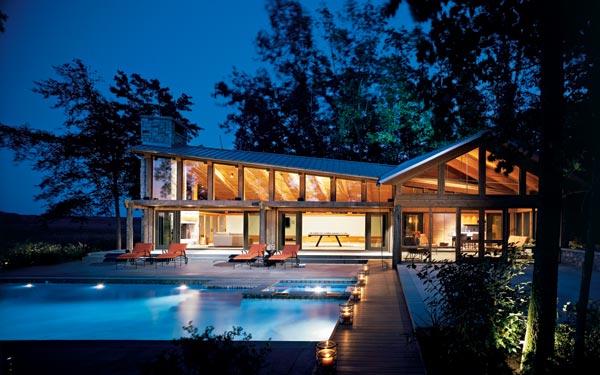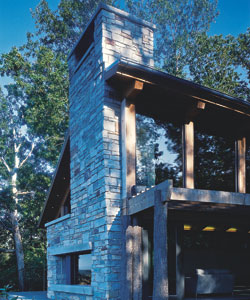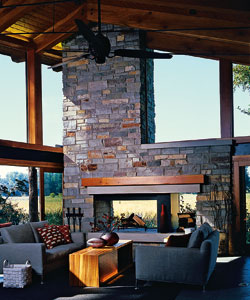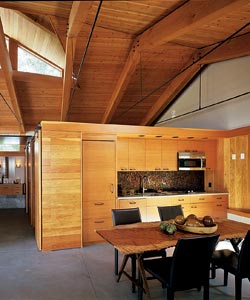 |
|
Support columns are made with white pine tree trunks, bark intact—a "symbolic remnant of the site," the homeowner says. The window walls build to a height of 16 feet at their tallest points. Bold angles and strategic lighting create a striking effect after dark. |
When Kenilworth residents Tom and Becky Stilp bought a summer house in New Buffalo, Michigan,a few years ago, they knew they wanted the natural beauty of the area to play a big role in their life there. Their three-acre site, which includes a wooded lot, overlooks a scenic wetland and the Galien River.
 |
|
Local materials, including Douglas fir and bluestone, were used inside and out.A glass panel set into the exterior wall of the fireplace enlarges the view in an unexpected way. |
But it didn’t have one thing they were eager to have—a really great space for entertaining friends and family. They wanted a party house, complete with pool, separate from the main house. To realize their dream, they turned to Chicago architect Robert J. Neylan, who is known for his contemporary designs and has built a number of pool houses.
When Neylan visited the site, he quickly saw the potential of the nearby marsh. "The view was too wonderful not to highlight," he says. During the summer, cattails and prairie grasses frame the occasional boat floating down the river, which runs into nearby Lake Michigan. In the fall, wild turkeys are a common sight; in winter, the river freezes and the vista becomes an austerely beautiful still-life-with-snow. Coyotes, hawks, deer, and other wildlife abound year-round.
For the party house, Neylan envisioned an airy space ("as if you’re inside the belly of a whale") crafted from local materials, including Douglas fir and bluestone. Massive wooden trusses splay out like the pages of an open book, holding up the roof; grand windows gradually increase from eight to 16 feet tall as the wetlands come into view. To connect the swimming pool with the spectacular scenery, Neylan suggested an infinity pool, which gives the illusion of water spilling over the edge into the marsh.
Since the whole pool area was designed to be as low to the ground and visually harmonious as possible, the diving board the Stilps’ children wanted was a problem. Instead, the homeowners opted for a small slide to please their eight-year-old son and six-year-old daughter. A whirlpool, inset into a corner of the larger pool, is delineated with the same bluestone used elsewhere. A narrow wood deck that runs alongside the pool, from the main house to the party house, hides a retractable vinyl pool cover. The far end of the pool appears edgeless—hence, the "infinity" effect. "The wetlands are reflected in the pool and the whole site is connected," Tom Stilp says.
 |
|
The main part of the space (opposite) is airy and open, "as if you’re inside the belly of a whale," says architect Robert J. Neylan. A concrete floor with a radiant-heat system was used poolside and throughout the house. |
The roof trusses presented their own challenge, as each one had to be cut to a different size. On-site assembly involved some suspense. "We were a little nervous to see if it would all fit together," Stilp recalls.
Everything did, and the result is a sophisticated space where nature looms large. Eighteen-foot-wide exterior roll-up screens can be lowered into place when the sliding doors below are opened, allowing breezes in and keeping bugs out. Stilp suggested they use Douglas firs cut down on the lot for the house’s beams; white pine tree trunks, bark intact, became giant support columns both inside and out. "They’re a symbolic remnant of the site," he says.
The interior and exterior are also tied together by the use of a stained poured concrete floor, a material Stilp wanted because it was less expensive and more practical than stone. A radiant-heat system was installed in the inside floor and the outside porch to make them more comfortable during cool weather.
A stone fireplace with a clear, heat-resistant glass panel set into its exterior wall brings the outdoors into the living room in a dramatic way. "This way you’re looking into the wetlands rather than into the fireplace," says Neylan.
He designed the rest of the house so that the bathrooms, showers (including one with steam), laundry, kitchen, closet, and Murphy bed are part of a self-contained box. Each element can be opened and closed with a set of sliding doors on a barn-door track. The kitchen has concrete countertops to match the floor; a back-splash of iridescent black glass tile echoes the exposed steel hardware.
 |
|
Sliding doors on barn-door tracks hide bathrooms, a laundry area, a closet, and a Murphy bed. |
The Stilps completed the interior design with the help of Neylan and Tom’s sister-in-law, turning the grand yet simply furnished space into a place to hang out, watch movies, exercise, play billiards, and build a fire when it’s cold.
The retreat gets a lot of use. During the summer, the Stilps invite relatives and friends over for frequent barbecues. All guests must use the pool. "If you don’t swim, you get pushed in," Stilp says. Partygoers are amazed by the panoramic view, especially when the sun sets.
The family also uses the house over Thanksgiving for family reunions. "It’s a catalyst to bring everyone together," including a brother who flies in from Los Angeles for the event, Stilp notes. The scenery at that time of year is particularly breathtaking.
"You can leave Chicago where there’s no snow, and come here where there’s six inches," he says. "Even though Chicago’s close, the weather can be very different." The weather, and the living.
For resource information, see Buyer’s Guide.
Photography: Nathan Kirkman
Styling: Diane Ewing


